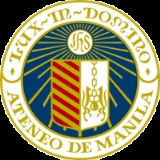
Loyola Schools
Encyclopedia
The Loyola Schools is the higher education unit of the Ateneo de Manila University
that offers undergraduate and graduate degree programs in the Arts and Sciences. It operates under the statutes of the Ateneo de Manila University. It is located in the Loyola Heights campus of the Ateneo de Manila University.
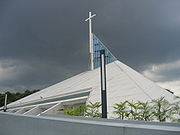 The Loyola Schools is headed by a Vice-President, appointed by the Board of Trustees. The vice-president's term usually lasts three years. Each of the schools, in turn is headed by a dean. The current Vice-President is John Paul C. Vergara, Ph.D.
The Loyola Schools is headed by a Vice-President, appointed by the Board of Trustees. The vice-president's term usually lasts three years. Each of the schools, in turn is headed by a dean. The current Vice-President is John Paul C. Vergara, Ph.D.
 Official Website: http://soh.ateneo.edu/
Official Website: http://soh.ateneo.edu/
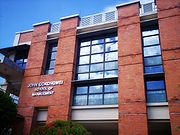 Official Website: http://ls.ateneo.edu/jgsom
Official Website: http://ls.ateneo.edu/jgsom
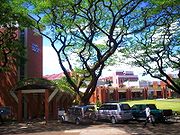 Official Website: http://sose.ateneo.edu/
Official Website: http://sose.ateneo.edu/
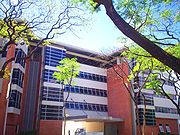 Official Website: http://socsci.ateneo.edu/
Official Website: http://socsci.ateneo.edu/
(AB), Bachelor of Science
(BS), and Bachelor of Fine Arts
(BFA) at the undergraduate level, and Master of Arts
(MA), Master of Science
(MS), and Doctor of Philosophy
(Ph.D.) at the graduate level. Concentrations vary and are offered as different degree programs.
Aside from the degree programs, the Loyola Schools also offer minor concentration programs in different fields. These are meant to allow students to pursue studies in other fields of their interest, as well as provide a wider range of career options.
Students are also encouraged to work with their professors, especially in areas of their interest. All faculty are evaluated by students each semester, and there are annual faculty activity reports and faculty peer evaluations.
Facilities are also developed with this mindset. In 2004, the Matteo Ricci Study Hall was completed. In 2006, the Manuel V. Pangilinan Center for Student Leadership was completed. The Center for Student Leadership houses student organizations as well as numerous student services units.
COEs/CODs in the different disciplines were identified and carefully selected for funding assistance. Funds released to these centers were utilized for student scholarships, faculty development, library and laboratory upgrading, research and extension services, instructional materials development, and networking of existing COEs and CODs.
The following is a list as of December 2007.
Centers of Excellence
Centers of Development
Student research publications include:
The School of Science and Engineering also awards outstanding student research, as well as outstanding science writing, photography, and science-related creative work.
Student news and creative publications are organized into the Council of Publications and include:
The Loyola Schools Awards for the Arts gives recognition to outstanding work by graduating students in the following categories: creative writing (fiction, poetry, drama, essay), dance, graphic design, music, photography, screen arts, theater arts, and visual arts. There is also a Fine Arts Festival held by the students in the Fine Arts Program, featuring original plays, multimedia exhibits, and readings of literary works. Outstanding work in student journalism is also recognized by the Raul Locsin Awards for Student Journalism.
The EDSA Walk starts in front of the College Cafeteria at Gonzaga Hall, passing through the entrances to Berchmans and Kostka, and ends in Xavier Hall, which is home to the Office of the University President and the cashiers.
building, with the special collections and Ateneo Art Gallery, and the Rizal Library Annex, housing the University Archives and Rizal Mini-Theater; Schmitt Hall, home to the Department of Chemistry; the Manuel V. Pangilinan Center for Student Leadership (built on the site of the old Colayco Hall), which houses offices of student organizations and the University Bookstore, and Colayco Pavilion. All of these buildings are located along College Lane, on which also stand the Social Sciences Building, home of the University Registrar and the Psychology and Communication departments; De La Costa Hall, the home of the School of Humanities
; Faura Hall, which houses the departments of physics, computer science, and engineering, and the Philippine Institute of Pure and Applied Chemistry.
The portion of College Lane stretching from the entrance at University Avenue until just after Faura Hall is paved with brick and is off-limits to vehicles. From Schmitt Hall to the exit at Father Masterson Drive, the road is asphalted; part of it serves as a parking area for faculty and student carpoolers.
, the departments of Mathematics and Biology, and the Health Sciences program. Specialized facilities include a small collection of stuffed, preserved animals and a greenhouse. The SEC was built in 1997 as part of an aggressive expansion program. The buildings' architecture were inspired by the old Ateneo Municipal in Intramuros.
Joining the SEC via a covered walk are the PLDT Convergent Technologies Center and the John Gokongwei School of Management
. The PLDT Convergent Technologies Center houses classrooms, lecture rooms, and laboratories for engineering students. The JGSOM building, on the other hand, hosts the Ching Tan Lecture Room and the faculty offices of the JGSOM. While the Rizal Library was being renovated in the middle of the 2000s, the Circulation Section was transferred to the JGSOM classrooms. Both the PLDT-CTC and JGSOM buildings were finished in 2002 and follow almost the same template as the SEC buildings.
Between and behind SEC buildings B and C is the Matteo Ricci Study Hall, and behind the PLDT CTC is the JGSOM Student Enterprise Center. Behind the JGSOM and PLDT CTC buildings are Eagles' Park, a mini-arboretum, and a walk leading to Leong Hall.
The quadrangle formed by the SEC covered walk and College Lane is often used for food sales and student fundraisers. In recent years, it has been host to sportsfests and cultural activities.
, which hosts the Department of Environmental Science; the former Communications Department building, located on Seminary Road, is noted for the mural painted across its facade. Across the Communications Department building are the offices of the Physical Education Department, the tennis courts, the shooting range, and the College Covered Courts.
(dormitories for men and women), the Church of the Gesu
, the John Pollock Renewal Center, and the University Dormitory
. The Church of the Gesu holds 1,000 people and features a nineteen-bell carillon. Behind the Church of the Gesu are the Cervini-Eliazo Residence Halls and University Dormitory that have a combined capacity of more than 800 beds. The John Pollock Renewal Center is used for retreats and workshops.
All the residence halls have a commanding view of the Marikina Valley and the Sierra Madre
.
), and the new Rizal Library building. The avenue ends at Gate 3, which opens to Katipunan Avenue.
Two hundred meters across Xavier Hall is Bellarmine Hall, which used to be the dormitory before the Cervini and Eliazo Halls were built. Bellarmine Hall now houses classroms and the Ateneo de Manila University Press
. Between Xavier and Bellarmine halls is Bellarmine Field, used for ROTC drills and university-wide celebrations such as UAAP championship bonfires.
Also accessible from University Avenue are the Social Development Complex and the Institute for Social Order.
Across Father Masterson Drive are a concrete squash court and the Erenchun and Ocampo fields. The Erenchun and Ocampo fields are used by the Ateneo soccer varsity teams and host the UAAP soccer tournament. Across the soccer fields near Gate 2 is the Blue Eagle Gym.
The baseball field is located along University Avenue, just after entering Gate 3, in front of the new Rizal Library
building and Leong Hall.
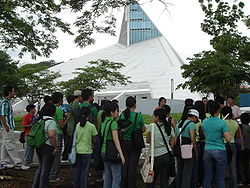 The Ateneo has one of the most robust student organizations network in the Philippines. The latest figures show that almost 80% of the entire student population is enrolled in one organization or another.
The Ateneo has one of the most robust student organizations network in the Philippines. The latest figures show that almost 80% of the entire student population is enrolled in one organization or another.
of Undergraduate Rights. The Loyola Schools, according to the Magna Carta, "upholds the rights of students as one of its foundational principles." Ateneo students are given leverage with regard to their rights as students, consistent with the University's commitment to student-centeredness. Students are granted rights with regard to academics, access to information, freedom of expression, participation in school policy-making, organization, security, and due process (especially in disciplinary proceedings).
The Loyola Schools Student Council, the Sanggunian ng mga Mag-aaral ng mga Paaralang Loyola ng Ateneo, is known for its moderate policies and adaptability. The Sanggunian has a history of active and committed social involvement, and brands itself "left-leaning", because of some of its actions and associations. However, the Ateneo's Sanggunian fosters much more moderate ideals than most other Filipino student councils, leading some to criticize it for being too passive in recent years.
Faith Formation Cluster
Health and Environment Cluster
Intercultural Relations Cluster
Issue and Policy Analysis Cluster
Media and the Creative Arts Cluster
Performing Arts Cluster
Sector Based Cluster
Science and Technology Cluster
The initiatives have mostly been focused on solid waste management and water and energy resource management though parallel initiatives have been consistent in other areas - green architecture and design is being incorporated into new buildings on campus and major changes on student lifestyles through campaigns and participative exercises are also on the fore.
Ateneo de Manila University
The Ateneo de Manila University is a private teaching and research university run by the Society of Jesus in the Philippines. It began in 1859 when the City of Manila handed control of the Escuela Municipal de Manila in Intramuros, Manila, to the Jesuits...
that offers undergraduate and graduate degree programs in the Arts and Sciences. It operates under the statutes of the Ateneo de Manila University. It is located in the Loyola Heights campus of the Ateneo de Manila University.
Institution

John Paul Vergara
John Paul C. Vergara is a Professor at the Department of Information Systems and Computer Science, School of Science and Engineering, Ateneo de Manila University. He is currently the Vice President for the Loyola Schools of the University, succeeding Ma. Assunta Cuyegkeng, Ph.D..- Education...
Schools
The Loyola Schools is composed of the School of Humanities, the John Gokongwei School of Management, the School of Science and Engineering, and the School of Social Sciences.School of Humanities
Dean: Ma. Luz C. Vilches, Ph.D.
- Department of English
- Department of Filipino / Kagawarán ng Filipino
- Department of Interdisciplinary Studies
- Department of Modern Languages
- Department of Philosophy
- Department of Theology
- Fine Arts Program
John Gokongwei School of Management
Dean: Rodolfo P. Ang, MBA
- Department of Finance and Accounting
- Department of Leadership and Strategy
- Department of Marketing and Law
- Department of Quantitative Methods and Information Technology
School of Science and Engineering
Dean: Fabian M. Dayrit, Ph.D.
- Department of Biology
- Department of Chemistry
- Department of Environmental Science
- Department of Information Systems and Computer Science
- Department of Mathematics
- Department of Physics
- Department of Electronics, Computer, and Communications Engineering
- Health Sciences Program
School of Social Sciences
Dean: Fr. José M. Cruz, S.J.Society of Jesus
The Society of Jesus is a Catholic male religious order that follows the teachings of the Catholic Church. The members are called Jesuits, and are also known colloquially as "God's Army" and as "The Company," these being references to founder Ignatius of Loyola's military background and a...

- Chinese Studies Program
- Department of Communication
- Department of Economics
- Department of Education
- Department of History
- Department of Political Science
- Department of Psychology
- Department of Sociology and Anthropology
- Development Studies Program
- European Studies Program
- Japanese Studies Program
Academic Programs
The Ateneo Loyola Schools confer the following degrees: Bachelor of ArtsBachelor of Arts
A Bachelor of Arts , from the Latin artium baccalaureus, is a bachelor's degree awarded for an undergraduate course or program in either the liberal arts, the sciences, or both...
(AB), Bachelor of Science
Bachelor of Science
A Bachelor of Science is an undergraduate academic degree awarded for completed courses that generally last three to five years .-Australia:In Australia, the BSc is a 3 year degree, offered from 1st year on...
(BS), and Bachelor of Fine Arts
Bachelor of Fine Arts
In the United States and Canada, the Bachelor of Fine Arts degree, usually abbreviated BFA, is the standard undergraduate degree for students seeking a professional education in the visual or performing arts. In some countries such a degree is called a Bachelor of Creative Arts or BCA...
(BFA) at the undergraduate level, and Master of Arts
Master of Arts (postgraduate)
A Master of Arts from the Latin Magister Artium, is a type of Master's degree awarded by universities in many countries. The M.A. is usually contrasted with the M.S. or M.Sc. degrees...
(MA), Master of Science
Master of Science
A Master of Science is a postgraduate academic master's degree awarded by universities in many countries. The degree is typically studied for in the sciences including the social sciences.-Brazil, Argentina and Uruguay:...
(MS), and Doctor of Philosophy
Doctor of Philosophy
Doctor of Philosophy, abbreviated as Ph.D., PhD, D.Phil., or DPhil , in English-speaking countries, is a postgraduate academic degree awarded by universities...
(Ph.D.) at the graduate level. Concentrations vary and are offered as different degree programs.
Aside from the degree programs, the Loyola Schools also offer minor concentration programs in different fields. These are meant to allow students to pursue studies in other fields of their interest, as well as provide a wider range of career options.
A focus on student-centered development
The Ateneo de Manila's teaching methods are geared toward student-centered learning. Faculty undergo training by the Loyola Schools' Teacher Formation Institute. Teaching materials and methods are planned with under a student-centered framework, with participation, individual and group projects, individual and group mentoring by faculty and selected individuals, and other similar elements given a premium over other coursework.Students are also encouraged to work with their professors, especially in areas of their interest. All faculty are evaluated by students each semester, and there are annual faculty activity reports and faculty peer evaluations.
Facilities are also developed with this mindset. In 2004, the Matteo Ricci Study Hall was completed. In 2006, the Manuel V. Pangilinan Center for Student Leadership was completed. The Center for Student Leadership houses student organizations as well as numerous student services units.
Core Curriculum
Aside from their major concentration subjects, all undergraduate students are required to take up subjects that form a multidisciplinary core curriculum. This curriculum is split across the four or five year-long programs, and consists of classes in English and Filipino language and literature, foreign language (Spanish, Russian, German, Portuguese, French, Italian, Latin, Bahasa Indonesia, Mandarin, Korean, and Japanese are currently offered), mathematics, natural sciences, sociology and psychology, and history. Classes in philosophy and theology are billed as the centerpiece of the core curriculum.Centers of Excellence and Development for Excellence
Centers of Excellence (COEs) and Centers of Development (CODs) are institutions which, as identified by the Commission on Higher Education (CHED), have demonstrated the highest degree or level of standards along the areas of instruction, research and extension. They provide institutional leadership in all aspects of development in specific areas of discipline in the various regions by providing networking arrangements to help ensure the accelerated development of HEIs in their respective service areas.COEs/CODs in the different disciplines were identified and carefully selected for funding assistance. Funds released to these centers were utilized for student scholarships, faculty development, library and laboratory upgrading, research and extension services, instructional materials development, and networking of existing COEs and CODs.
The following is a list as of December 2007.
Centers of Excellence
- Business Administration
- Chemistry
- English
- Entrepreneurship
- Information Technology
- Literature
- Mathematics
- Philosophy
- Physics
- Psychology
- Sociology
Centers of Development
- Biology
- Environmental Science
CHED-FAPE Evaluation of Graduate Programs
In 2003-2004, the CHED and the Fund for Assistance to Private Education (FAPE) conducted a nationwide survey and evaluation of graduate programs focusing on teacher education, covering the eares of curriculum, instruction, faculty, students, institutional support, physical facilities, learning centers, and research and extension services. The Loyola Schools emerged as the top-ranked institution for graduate programs in teacher education.Research
Aside from teaching, the Loyola Schools engages in research work through various research units within the Loyola Schools and with other units of the Ateneo de Manila University. Faculty are given incentives by the Loyola Schools and other grant-giving organizations.Scholarly publications
Among the scholarly publications published by the Loyola Schools are:- The Loyola Schools Review - with four books for every volume, one for each of the four schools: Loyola Schools Review: School of Humanities, Loyola Schools Review: John Gokongwei School of Management, Loyola Schools Review: School of Science and Engineering, Loyola Schools Review: School of Social Sciences. It is distributed in the Philippines, Asia, Europe, and America. (Published by the Office of Research and Publications.)
- Budhi - the Loyola Schools interdisciplinary journal of ideas and culture focusing especially on the humanities and social sciences. It is distributed worldwide. (Published by the Ateneo de Manila University Press.)
- Kritika Kultura - an electroic journal of language, literary, and cultural studies published by the Department of English, School of Humanities, which focuses on issues relevant to the 21st century.
- Philippine Studies - technically not published by the Loyola Schools, but by the whole university, this periodical is an internationally refereed journal that publishes a wide variety of scholarly and original articles by younger as well as established scholars. Past editors-in-chief include Fr. Horacio de la Costa, S.J.Horacio de la CostaHoracio V. de la Costa was the first Filipino Provincial Superior of the Society of Jesus in the Philippines, and a recognized authority in Philippine and Asian culture and history....
and Fr. Roque Ferriols, S.J.. (Published by the Ateneo de Manila University Press.)
Student research and creative work
Students also engage in research and creative work as part of their academic formation and extracurricular development.Student research publications include:
- The Ateneo Student Business Review - A research journal published by students of the John Gokongwei School of Management, focusing on the local and international business environment, entrepreneurship, as well as business research and business plans by students of the JGSOM.
- The Ateneo Student Review for the Social Sciences - A research journal published by students of the School of Social Sciences, focusing on social, political, and economic issues.
- Pilosopo Tasyo - The official scholarly publication of the Samahan ng Pilosopiya ng Ateneo de Manila, focusing on student work in philosophy.
The School of Science and Engineering also awards outstanding student research, as well as outstanding science writing, photography, and science-related creative work.
Student news and creative publications are organized into the Council of Publications and include:
- The GUIDONThe GUIDONThe GUIDON is the official student newspaper of the Ateneo de Manila University. It is a part of the Ateneo's Confederation of Publications , including Heights and Matanglawin...
, the monthly newspaper in English, covering both Ateneo news and issues outside the campus - MatanglawinMatanglawinMatanglawin, literally meaning "Hawk's Eye" and usually contracted as Mata, is the official student newspaper of the Ateneo de Manila University in the Filipino language. The student paper dedicates itself to discussing socio-political events in the Philippines, the plight and suffering of the...
, the quarterly magazine in Filipino, featuring investigative journalism about Ateneo and national issues - HeightsHeightsHeights is a 2004 Merchant Ivory Productions film that follows a pivotal twenty-four hours in the interconnected lives of five New Yorkers...
, the official literary publication, published in both English and Filipino - AegisAegisAn aegis is a large collar or cape worn in ancient times to display the protection provided by a high religious authority or the holder of a protective shield signifying the same, such as a bag-like garment that contained a shield. Sometimes the garment and the shield are merged, with a small...
, the senior yearbook, released every March.
The Loyola Schools Awards for the Arts gives recognition to outstanding work by graduating students in the following categories: creative writing (fiction, poetry, drama, essay), dance, graphic design, music, photography, screen arts, theater arts, and visual arts. There is also a Fine Arts Festival held by the students in the Fine Arts Program, featuring original plays, multimedia exhibits, and readings of literary works. Outstanding work in student journalism is also recognized by the Raul Locsin Awards for Student Journalism.
Research centers and facilities
- Ateneo Center for Asian Studies
- Ateneo Center for Economic Research and Development
- Ateneo Center for English Language Training
- Ateneo Center for Organization Research and Development
- Ateneo Center for Psychological and Educational Assessment
- Ateneo Information Design Studio
- Ateneo Institute of Literary Arts and Practices
- Ateneo Java Wireless Competency Center
- Ateneo Language Learning Center
- Ateneo Macroeconomic Research Unit
- Ateneo-PLDT Advanced Network Testbed
- Ateneo Research Network for Development
- Ateneo Teacher Center
- Center for Communication Research and Technology
- Institute of Philippine Culture
- John Gokongwei School of Management Business Accelerator (SOMBA)
- John Gokongwei School of Management Business Resource Center
- Konrad Adenauer Asian Center for Journalism (ACFJ)
- National Chemistry Instrumentation Center
- Ricardo Leong Center for Chinese Studies
Student Services and Units
In 2006, the Commission on Higher Education cited the Loyola Schools for having the most comprehensive student services program in the Philippines http://www.ateneo.edu/index.php?p=120&type=2&sec=29&aid=2430.- Office of the Associate Dean for Student Affairs
- Loyola Schools Guidance Office
- Office of Social Concern and Involvement
- Office of Student Activities
- Campus Ministry Office
- College Athletics Office
- Cervini and Eliazo Residence Halls
- Ateneo Placement Office
- Office of Admission and Aid
- Office of International Programs
- Office of Administrative Services
Campus
The Loyola Schools still clings to its past as a single College of Arts and Sciences, and this is no more evident than in the arrangement of its academic buildings.College Quad
The Loyola Schools campus is organized around what is commonly called the "College Quad", a square which is bounded by the first academic buildings to rise in the Loyola Heights campus: Kostka Hall, Gonzaga Hall, and Berchmans Hall. Kostka Hall houses the Office of Admission and Aid; Gonzaga Hall is home to the College Cafeteria, the Fine Arts Program, and the Immaculate Conception Chapel; Berchmans Hall hosts the Placement Office and the College Guidance Office. Both Kostka and Berchmans halls hold classrooms that are shared by the schools of Humanities and Social Sciences.The EDSA Walk starts in front of the College Cafeteria at Gonzaga Hall, passing through the entrances to Berchmans and Kostka, and ends in Xavier Hall, which is home to the Office of the University President and the cashiers.
College Lane
Other buildings in what used to be the central campus include the old Rizal LibraryRizal Library
The Rizal Library is the main university library of the Ateneo de Manila University. It mainly serves and supports the teaching and research in the Loyola Schools...
building, with the special collections and Ateneo Art Gallery, and the Rizal Library Annex, housing the University Archives and Rizal Mini-Theater; Schmitt Hall, home to the Department of Chemistry; the Manuel V. Pangilinan Center for Student Leadership (built on the site of the old Colayco Hall), which houses offices of student organizations and the University Bookstore, and Colayco Pavilion. All of these buildings are located along College Lane, on which also stand the Social Sciences Building, home of the University Registrar and the Psychology and Communication departments; De La Costa Hall, the home of the School of Humanities
Ateneo School of Humanities
The Ateneo de Manila School of Humanities is one of the four Loyola Schools of the Ateneo de Manila University.-History: In 2000, the School of Arts and Sciences of the university, which comprises the College and the Graduate School, restructured into the four Loyola Schools of Humanities,...
; Faura Hall, which houses the departments of physics, computer science, and engineering, and the Philippine Institute of Pure and Applied Chemistry.
The portion of College Lane stretching from the entrance at University Avenue until just after Faura Hall is paved with brick and is off-limits to vehicles. From Schmitt Hall to the exit at Father Masterson Drive, the road is asphalted; part of it serves as a parking area for faculty and student carpoolers.
Science Education Complex, PLDT Convergent Technologies Center, and John Gokongwei School of Management
Beyond College Lane is the Science Education Complex, composed of three buildings, each housing classrooms, plenary lecture halls, and science laboratories. The SEC is also home to the office of the dean of the School of Science and EngineeringAteneo School of Science and Engineering
The Ateneo de Manila School of Science and Engineering is one of the four Loyola Schools of the Ateneo de Manila University.-History:In 2000, the School of Arts and Sciences of the university, which comprises the College and the Graduate School, restructured into the four Loyola Schools of...
, the departments of Mathematics and Biology, and the Health Sciences program. Specialized facilities include a small collection of stuffed, preserved animals and a greenhouse. The SEC was built in 1997 as part of an aggressive expansion program. The buildings' architecture were inspired by the old Ateneo Municipal in Intramuros.
Joining the SEC via a covered walk are the PLDT Convergent Technologies Center and the John Gokongwei School of Management
Ateneo John Gokongwei School of Management
The Ateneo de Manila John Gokongwei School of Management is one of the four Loyola Schools of the Ateneo de Manila University.-History: In 2000, the School of Arts and Sciences of the university, which comprises the College and the Graduate School, restructured into the four Loyola Schools of...
. The PLDT Convergent Technologies Center houses classrooms, lecture rooms, and laboratories for engineering students. The JGSOM building, on the other hand, hosts the Ching Tan Lecture Room and the faculty offices of the JGSOM. While the Rizal Library was being renovated in the middle of the 2000s, the Circulation Section was transferred to the JGSOM classrooms. Both the PLDT-CTC and JGSOM buildings were finished in 2002 and follow almost the same template as the SEC buildings.
Between and behind SEC buildings B and C is the Matteo Ricci Study Hall, and behind the PLDT CTC is the JGSOM Student Enterprise Center. Behind the JGSOM and PLDT CTC buildings are Eagles' Park, a mini-arboretum, and a walk leading to Leong Hall.
The quadrangle formed by the SEC covered walk and College Lane is often used for food sales and student fundraisers. In recent years, it has been host to sportsfests and cultural activities.
Father Masterson Drive
Along Father Masterson Drive, the road linking the Blue Eagle Gym, Grade School, Loyola Schools, and the High School, lie the Manila ObservatoryManila Observatory
The Manila Observatory is a non-profit research institute housed in the campus of the Ateneo de Manila University in Quezon City, Philippines.Founded in 1865 by the Jesuits, it has served many purposes over the years including weather...
, which hosts the Department of Environmental Science; the former Communications Department building, located on Seminary Road, is noted for the mural painted across its facade. Across the Communications Department building are the offices of the Physical Education Department, the tennis courts, the shooting range, and the College Covered Courts.
Residence Hall Area and Church of the Gesu
Further down Father Masterson Drive are Alingal Hall, the Cervini-Eliazo Residence HallsCervini-Eliazo Residence Halls
Cervini Hall and Eliazo Hall are the on-campus dormitories for college students of the Ateneo de Manila University. Cervini Hall is for male students, and neighboring Eliazo Hall is for female students. Located at the highest point of the campus, it can accommodate 204 male students in 51 rooms...
(dormitories for men and women), the Church of the Gesu
Church of the Gesu (Philippines)
The Church of the Gesù is a landmark church of the Ateneo de Manila University campus in the Philippines. Designed by Jose Pedro Recio and Carmelo Casas, the edifice’s massive triangular structure symbolizes the Holy Trinity, as well as the three-fold mission and vision of the school...
, the John Pollock Renewal Center, and the University Dormitory
Ateneo de Manila University Dormitory
The Ateneo de Manila University Dormitory is a twin-building, on-campus dormitory for college students of the Ateneo de Manila University. Built in 2008, the Dormitory buildings stand seven stories high, and can accommodate over 600 students...
. The Church of the Gesu holds 1,000 people and features a nineteen-bell carillon. Behind the Church of the Gesu are the Cervini-Eliazo Residence Halls and University Dormitory that have a combined capacity of more than 800 beds. The John Pollock Renewal Center is used for retreats and workshops.
All the residence halls have a commanding view of the Marikina Valley and the Sierra Madre
Sierra Madre (Philippines)
The Sierra Madre is a mountain range in The Philippines. It is located along the north-eastern coast of Luzon Island, running north/south. Quezon National Forest Park is situated in the range.-Geography:...
.
University Avenue
University Avenue starts between the Church of the Gesu and the Cervini-Eliazo Field. Xavier Hall and the Rizal Library Annex are also located along University Avenue, as well as the Social Science Building, Leong Hall (faculty center of the School of Social SciencesAteneo School of Social Sciences
The Ateneo de Manila School of Social Sciences is one of the four Loyola Schools of the Ateneo de Manila University.-History: In 2000, the School of Arts and Sciences of the university, which comprises the College and the Graduate School, restructured into the four Loyola Schools of Humanities,...
), and the new Rizal Library building. The avenue ends at Gate 3, which opens to Katipunan Avenue.
Two hundred meters across Xavier Hall is Bellarmine Hall, which used to be the dormitory before the Cervini and Eliazo Halls were built. Bellarmine Hall now houses classroms and the Ateneo de Manila University Press
Ateneo de Manila University Press
The Ateneo de Manila University Press is a university press and the official publishing house of Ateneo de Manila University in the Philippines. The mission statement of the Press is to preserve national heritage, both in the Philippines and abroad, and thus dedicates itself to publishing writings...
. Between Xavier and Bellarmine halls is Bellarmine Field, used for ROTC drills and university-wide celebrations such as UAAP championship bonfires.
Also accessible from University Avenue are the Social Development Complex and the Institute for Social Order.
Athletic Facilities
The College Covered Courts have seven regulation-sized concrete basketball courts that can be converted to futsal, a volleyball court, shower rooms, a bodybuilding gym, and a half-Olympic swimming pool that is used by both swimming classes and the varsity swimming teams for training and dual meets. Also in the same complex are the tennis courts, the offices of the physical education department, and a shooting range used by the rifle and pistol varsity team, the first of its kind in the Philippines.Across Father Masterson Drive are a concrete squash court and the Erenchun and Ocampo fields. The Erenchun and Ocampo fields are used by the Ateneo soccer varsity teams and host the UAAP soccer tournament. Across the soccer fields near Gate 2 is the Blue Eagle Gym.
The baseball field is located along University Avenue, just after entering Gate 3, in front of the new Rizal Library
Rizal Library
The Rizal Library is the main university library of the Ateneo de Manila University. It mainly serves and supports the teaching and research in the Loyola Schools...
building and Leong Hall.
Students

A Magna Carta for Students
The Ateneo de Manila Loyola Schools is among the first universities in the Philippines to adopt a Magna CartaMagna Carta
Magna Carta is an English charter, originally issued in the year 1215 and reissued later in the 13th century in modified versions, which included the most direct challenges to the monarch's authority to date. The charter first passed into law in 1225...
of Undergraduate Rights. The Loyola Schools, according to the Magna Carta, "upholds the rights of students as one of its foundational principles." Ateneo students are given leverage with regard to their rights as students, consistent with the University's commitment to student-centeredness. Students are granted rights with regard to academics, access to information, freedom of expression, participation in school policy-making, organization, security, and due process (especially in disciplinary proceedings).
The Sanggunian ng mga Mag-aaral ng mga Paaralang Loyola ng Ateneo de Manila
The Loyola Schools' student council is officially named the Sanggunian ng mga Mag-aaral ng mga Paaralang Loyola ng Ateneo de Manila.The Loyola Schools Student Council, the Sanggunian ng mga Mag-aaral ng mga Paaralang Loyola ng Ateneo, is known for its moderate policies and adaptability. The Sanggunian has a history of active and committed social involvement, and brands itself "left-leaning", because of some of its actions and associations. However, the Ateneo's Sanggunian fosters much more moderate ideals than most other Filipino student councils, leading some to criticize it for being too passive in recent years.
Council of Organizations of the Ateneo
Business Cluster- Ateneo Lex (LEX)
- Ateneo Association of Communications Technology Management (ACTM)
- AIESEC
- Ateneo Junior Marketing Association (AJMA)
- Ateneo Management Association (AMA)
- Management Engineering Association (MEA)
- Management Economics Organization (MEcO)
- Management of Applied Chemistry Association (MACA)
Faith Formation Cluster
- Ateneo Catechetical Instructional League (ACIL)
- Ateneo Christian Life Community (ACLC)
- Ateneo Student Catholic Action (AtSCA)
- Ateneo Youth for Christ (YFC)
Health and Environment Cluster
- Environmental Science Society (ESS)
- Loyola Mountaineers (LM)
- Pre-Med Society of the Ateneo (PMSA)
- Ateneo Peers
Intercultural Relations Cluster
- Ateneo Lingua Ars Cultura (ALAC)
- Ateneo Student Exchange (ASEC)
- Ateneo CELADON
Issue and Policy Analysis Cluster
- Ateneo Debate Society (ADS)
- Ateneo Economics Association (AEA)
- Ateneo Statistics Circle (A-Stat)
- Enterteynment para sa Tao, Bayan, Lansangan at Diyos (ENTABLADO)
- Ateneo Harvard Project for Asian and International Relations (HPAIR)
- The Assembly
- Development Society (DevSoc)
Media and the Creative Arts Cluster
- Association of Communication Majors (ACOMM)
- Ateneo Musicians Pool (AMP)
- Collegiate Society of Advertising (COSA)
- Loyola Film Circle (LFC)
Performing Arts Cluster
- Ateneo College Glee Club (ACGC)
- Blue Repertory (BlueRep)
- Company of Ateneo Dancers (CADS)
- Tanghalang Ateneo (TA)
Sector Based Cluster
- Ateneo-Gabay
- Kaingin
- Kythe Ateneo
- Musmos
- Ateneo Special Education Society (SPEED)
- Ateneo Student Trainers (STRAINS)
- Tugon
Science and Technology Cluster
- Ateneo Chemistry Society (ACheS)
- Ateneo Electronics and Computer Engineering Society (AECES)
- Ateneo Mathematical Society (AMS)
- Ateneo Biological Organization (BOX)
- Computer Society of the Ateneo (CompSAt)
- League of Ateneo Physicists (LEAPS)
- Management Information Systems Association (MISA)
- Ateneo Psyche
Environmental Initiatives
Recently, the Loyola Schools, as a community, have started major efforts in environmental impact reduction. These come under the banner of the Ateneo Environmental Management Coalition, a synergistic consortium of student organizations, administrative units, academic departments and external partners who share the common goal of fostering environmental sustainability as a common value for the community. The coalition takes pride in the diversity of approaches available to the body in fostering green efforts - allowing a healthy combination of the scientific and the systemic and, at the same time, ensuring maximal impact and participation from the community.The initiatives have mostly been focused on solid waste management and water and energy resource management though parallel initiatives have been consistent in other areas - green architecture and design is being incorporated into new buildings on campus and major changes on student lifestyles through campaigns and participative exercises are also on the fore.

